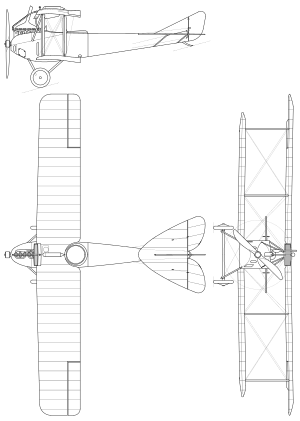LVG C.II
| LVG C.II | |
|---|---|

| |
| Mislabeled as an Albatros C.III in the Bundesarchiv photo collection; this is an LVG C.II. Note the Bergman machine gun in the observer's cockpit. | |
| Role | reconnaissance/light bomber |
| National origin | Germany |
| Manufacturer | Luft-Verkehrs-Gesellschaft |
| Introduction | late 1915 |
| Primary user | Luftstreitkräfte |
| Number built | c. 300 |
| Developed from | LVG B.I |
The LVG C.II was a 1910s German two-seat reconnaissance biplane designed at the Luft-Verkehrs-Gesellschaft for the Luftstreitkräfte.
Development
The C.II was developed from the LVG B.I, with the pilot and observer positions reversed, adding a ring-mounted machine gun to the rear. The increase in weight required a larger engine, the Benz Bz.III. Few C.I's were built before the C.II was introduced. It incorporated structural improvements and a more powerful engine.[1]
Operational history
The C.II was the first fixed-wing aircraft to bomb London, when six bombs were dropped near Victoria station on 28 November 1916.[1] (The first air raid on London was by the Zeppelin LZ 38, in the early hours of 1 June 1915.)
Variants
- LVG C.I - initial design, 120 kW (160 hp) Benz Bz.III engine.
- LVG C.II - production version.
- LVG C.III - single experimental aircraft, observer and machine gun moved to front.
- LVG C.IV - slightly larger, 160 kW (220 hp) Mercedes D.IV engine.
Operators
Specifications (C.II)

Data from Donald, David, The Encyclopedia of World Aircraft (pg 553). (1997). Prospero Books. ISBN 1-85605-375-X
General characteristics
- Crew: 2
- Capacity: 2
Performance
See also
Related lists
Notes
References
- Donald, David, The Encyclopedia of World Aircraft (pg 553). (1997). Prospero Books. ISBN 1-85605-375-X
- van Wyngarden, G (2006). Early German Aces of World War I, Osprey Publishing Ltd. ISBN 1-84176-997-5
